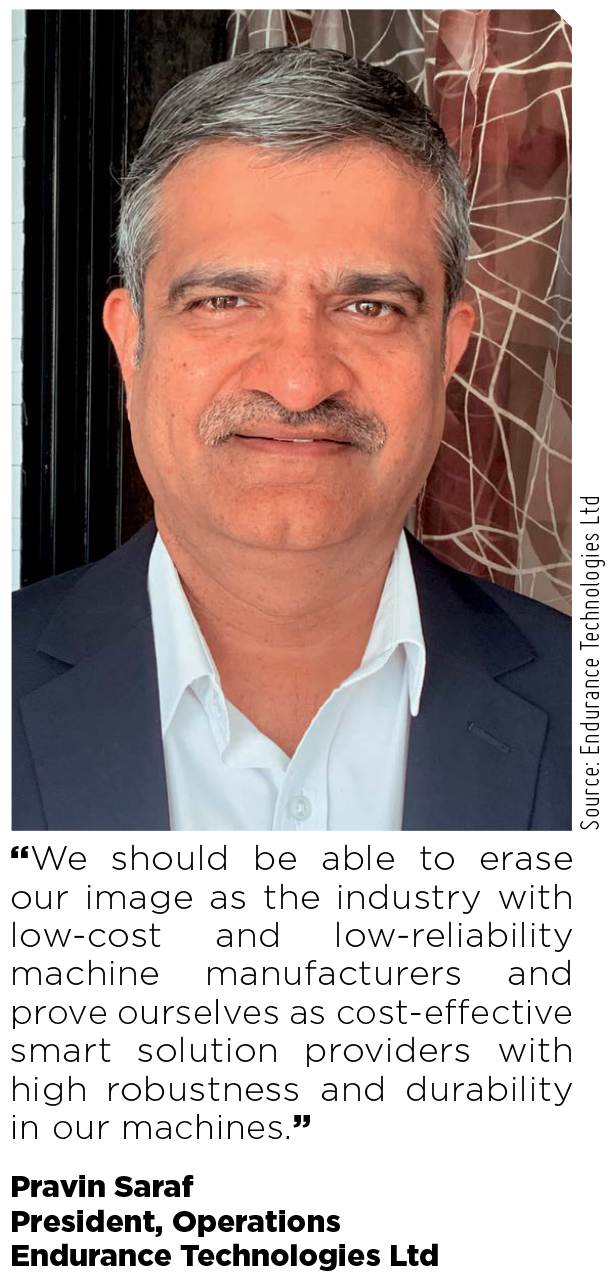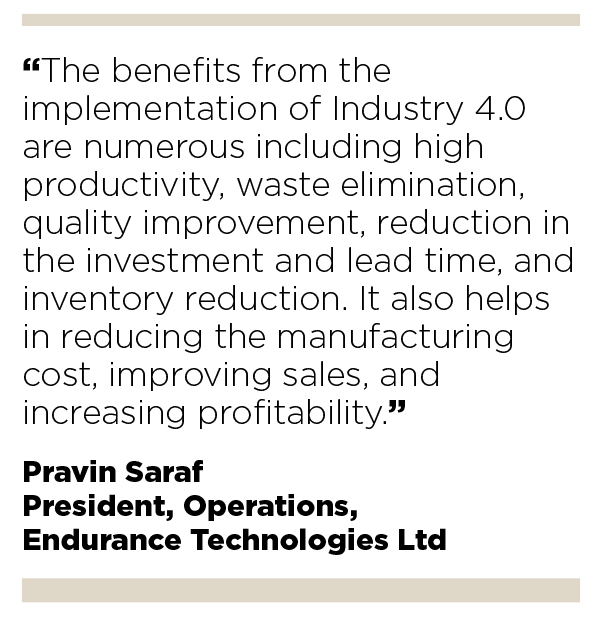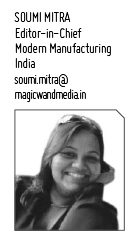THRIVING DURING CRISIS

You have had an impressive 29 years of national as well as international work experience in Manufacturing & Quality. It makes you an ideal person to shed light on the importance of maintaining quality to harness excellence in manufacturing.
Pravin Saraf : I have always believed that excellent product and process quality is a tool for achieving manufacturing excellence. Manufacturing excellence is achieved on the foundation of lean principles and its main pillars comprise – capable manufacturing processes; implementation of TPM practices; engaged and competent employees; high OEE (Overall Equipment Effectiveness) and smart manufacturing. These pillars ensure high quality standards. Process capability and TPM practices are prerequisites for sustained product quality. With engaged and skilled people as well as advanced technologies like Industry 4.0, standards can be followed and continuously improved.
With your extensive experience in the industry, what are the significant changes that you witness in today’s market?
Saraf : Today’s market can be best described as VUCA – volatile, uncertain, complex, and ambiguous. Nothing can be predicted to perfection. The demands are highly fluctuating and customer expectations are fast changing. At the same time, there is a quick response to changes in the PESTEL (Political, Economic, Social, Technological, Legal) environment. All this has an impact on the product lifecycle, which is reducing with increasing speed. The best example is the number of new models getting introduced every month in the Automotive industry. Quality and service expectations are increasing similarly. Customers are not accepting inferior quality in products and slow response in service. To meet customer expectations, there is more focus on the product and process innovation. What is proven is no more valid. An example is the time gap between the four industry evolutions in the Manufacturing industry. Industry 1.0 (Mechanization) happened in 1784; Industry 2.0 (Mass Production) in 1870, which is after 86 years; Industry 3.0 (Automation) in 1969, after 99 years; and Industry 4.0 (Internet of Things), the current one, has happened after 50 years.
The actual production, the actual sales, and projection for the customer demand in November are highly encouraging.
 With the Government of India’s initiative in adopting BS-VI and EV mobility and the current rapid technology transformation in the Automotive Manufacturing industry, India was expected to emerge as the world’s third-largest passenger-vehicle market by 2021. However, the emergence of the Covid-19 pandemic has disturbed the course that we were on. When, do you feel, will that goal be attained now?
With the Government of India’s initiative in adopting BS-VI and EV mobility and the current rapid technology transformation in the Automotive Manufacturing industry, India was expected to emerge as the world’s third-largest passenger-vehicle market by 2021. However, the emergence of the Covid-19 pandemic has disturbed the course that we were on. When, do you feel, will that goal be attained now?
Saraf : Covid-19 pandemic has had a big impact on the manufacturing supply chain. Besides, the political situation and the change in relation with various nations, the Government may need to relook at the strategy for the implementation of Electric Vehicles (EV). No one can predict when the expected growth will be visible, and the demand is back on track. The actual sales numbers of September, October and the projection for November are highly encouraging. If we can receive the Covid vaccine soon, we can see high demands after November too. Taking into account the domestic demand, higher projection of GDP growth, increasing aspirations of customers, and the Government’s push for EV, I hold no other view other than we are the third-largest passenger vehicle market. Only no one can predict whether that will surely be in 2021, mainly due to Covid uncertainty. A good thing is that the Indian industry is taking all the necessary efforts in preparing itself for the introduction of EVs and ensuring simplification of the supply chain.
How important do you think is embracing advanced technologies, such as Industry 4.0 for India to become a manufacturing powerhouse and come at par with its global peers? How far have we reached in this endeavour?
Saraf : The benefits from the implementation of Industry 4.0 are numerous including high productivity, waste elimination, quality improvement, reduction in the investment and lead time, and inventory reduction. It also helps in reducing the manufacturing cost, improving sales, and increasing profitability. Industry 4.0, with additional features of AI, is a distinctive advantage for the Indian industry to be at par with its global peers.
Although the initial response from the Indian industry was sluggish, in the recent 12 months, phenomenal progress has been witnessed in its adoption. Earlier, there was also considerable concern that automation could lead to an increase in unemployment. The Indian manufacturing industry has started embracing smart manufacturing where it deems crucial and of advantage to the local situation. We have developed a high amount of expertise and requisite skillsets to implement advanced technologies with our resources. Along with
big OEMs and Tier 1 companies, now Tier 2 and even smaller companies have become open to the idea. We can already witness excellent examples of digitalized factories. However, there is still a long way to go. In the coming year, we will observe a sea change in our products and processes, and witness more of digitalization.
In what way should Indian machine tool companies step up their game to meet global auto and component makers’ requirements?
Saraf : We have a highly established Machine Tool industry in India. It has a reputed history of continuous improvement. However, when we compare with the global benchmarks and as well the auto OEMs and auto component manufacturers’ expectations, the Indian Machine Tool industry should focus on
• Highly flexible concepts
• Compact machines with high speed
• Machines with Industry 4.0 features
• High robustness with less machine maintenance cost
• Availability of economical spares
• Ability to maintain accuracy for longer duration and usage
• Reduction in the lead time
• Necessary in-build automation.
We should be able to erase our image as the industry with low-cost and low-reliability machine manufacturers and prove ourselves as cost-effective smart solution providers with high robustness and durability in our machines.
Indian industry is taking all the necessary efforts in preparing itself for the introduction of EVs and ensuring simplification of the supply chain.
The domestic Automotive industry is expected to take five to seven quarters to recover from the impact of Covid-19. The Automotive Components industry is expected to follow a similar timeframe. Please comment.
Saraf : The Automotive Components industry is dependent on the domestic Automotive industry and the export market. The global markets are recovering. The Indian Automotive market is recovering faster than the global markets. Looking at the current Covid situation, it is difficult to predict how many quarters will take for the recovery to happen. However, the trends are encouraging. The actual production, the actual sales, and projection for the customer demand in November are highly encouraging. Hopefully, we soon find a solution to Covid to arrest the situation and witness a further increase in the demand and a faster recovery.
 Most companies are facing liquidity pressures due to high fixed costs, low capacity utilization until production ramps up and high levels of inventory. How is Endurance Technologies weathering the storm?
Most companies are facing liquidity pressures due to high fixed costs, low capacity utilization until production ramps up and high levels of inventory. How is Endurance Technologies weathering the storm?
Saraf : The key in this challenging time is ensuring cash flow so that our suppliers and service providers can be paid on time. This will help the supply chain to function smoothly and without any obstacles. We at ETL always have focus and control on the fixed cost, inventory, and receivables. Capital investment is one of the key drivers for increasing the fixed cost. To reduce inventory, we focus on reducing complexity in the supply chain. We are near to our customers and our supplier base is also in proximity to us. Also, we are not highly dependent on imports. Our manufacturing lines in different locations are highly flexible and can manufacture different types for different customers with less change over time.

Every year, there is an increasing focus on reducing changeover time. Our manpower is flexible and with systematic skill development, we have made our people capable of running more processes. There is a continuous effort towards making our manufacturing processes simple to operate.
Most of our tooling is manufactured with the in-house facility and with less lead time. Our manufacturing is based on lean principles and TPM. The same principles are followed in the entire supply chain -- at our suppliers as well as at our service providers. Lean principles ensure that we run with optimized inventory and no waste. TPM principles help us achieve our goals of zero accidents, zero failures in quality and deliveries. In Covid times, the same principles are applied to have zero Covid patients on our premises. We do this by taking adequate measures such as social distancing, temperature checks, Oxygen level measurement, and maintaining hygiene in the canteen and elsewhere. The pandemic situation has taught us a lesson to be prepared for worse situations and be lean, agile, and flexible in our products and processes to adapt to ever-changing scenarios.
Today’s market can be best described as VUCA – volatile, uncertain, complex, and ambiguous. Nothing can be predicted to perfection. The demands are highly fluctuating and customer expectations are fast changing. At the same time, there is a quick response to changes in the PESTEL (Political, Economic, Social, Technological, Legal) environment. All this has an impact on the product lifecycle, which is reducing with increasing speed.



 Facebook
Facebook.png) Twitter
Twitter Linkedin
Linkedin Subscribe
Subscribe